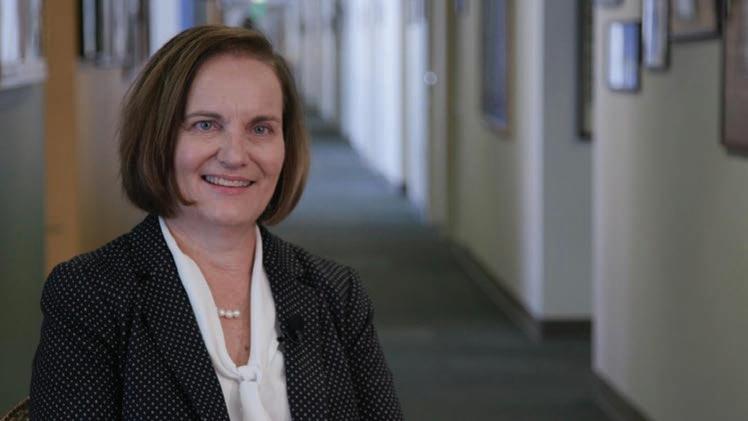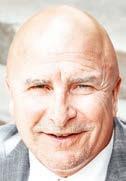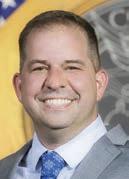Charity vending machine returns to Denver
BY ELICIA HESSELGRAVE SPECIAL TO COLORADO COMMUNITY MEDIA

Today, 10-year-old Jewell Jaussi understands that the holiday season is about giving. But that wasn’t always the case.
“When I was younger,” she said, “I thought Christmas was just about gifts.”
Something that helped her realize this is her family’s tradition of donating to the Light the World Giving Machines.
“Giving Machines are just like vending machines, but instead of getting stuff for yourself, you’re (purchasing) something for others,” Jaussi said.
Vending machines for donations
The Giving Machines are part of The Church of Jesus Christ of Latter-day Saints’ annual Light the World holiday initiative. The Giving Machines provide a unique opportunity for people to give to others, said Craig McIlroy, team lead for the Denver Giving Machines’ Organizing Committee.
“There’s a lot that divides us and (the Giving Machines) bring us together in a common purpose,” McIllroy said. “I think everybody agrees we should help those in need.”
How it works is people visit the Giving Machine — this year’s Denver machine will be located at Writer Square downtown — and select an item to donate to a charity. Upon selection, the donor is given a card-like receipt of their purchase. One hundred percent of every dollar contributed goes directly to the participating charities, and all overhead is covered through other sources, McIlroy said.
This year, donors can choose from
items that range in price from $5 to $250. A few examples include children’s bandages for $8, a kit of hygiene products for $30 and sponsoring a community garden for $250. Multiple donations can be made in a single transaction.
The Giving Machines “are a great example of how anyone can give at any amount to come together and support our community” and Metro Caring’s mission, said Brandon McKinley, communications and marketing specialist for Metro Caring.
Metro Caring is a Denver-based nonprofit that provides nutritious food to people while working to address the root causes of hunger. It is one of the local charities benefitting from the Giving Machine this year.


A family tradition
The Jaussi family — which consists of mother Heather; father Steven; Jewell; James, 7; and Adelaide, 1 — has been donating to the Denver Giving Machine since 2019.

“I love this tradition because it brings us together as a family to go serve and help others in need,” Jewell Jaussi said.
The tradition begins each year when the family visits the Giving Machine’s website to decide which items each family member wants to purchase for their donation. Then, donning their Light the World garb, the Jaussi family commutes from their Highlands Ranch home to attend the Unwrapping event in
‘We are staying’
Students at American Indian Academy of Denver speak up for their school
BY MELANIE ASMAR CHALKBEATCharlie Windy Boy was one of dozens of students, parents and community members who pleaded with the Denver school board on Nov. 28 not to close the American Indian Academy of Denver, a charter school that is struggling with low enrollment and funding.
Native American students told stories of being bullied in their previous schools but not at AIAD. They introduced themselves in Navajo and Lakota, and their parents spoke of the power of restoring those languages to their families. Community members wore black T-shirts that said, “DPS has a strange way of celebrating Native American Heritage Month.”
“You already took our land,” Windy Boy said. “Why are you trying to take our school?”
AIAD supporters were at the meeting because district officials have said they’re considering the unusual step of revoking the school’s charter for educational and financial reasons, including that the school may run out of money. But Superintendent Alex Marrero said he was “flabbergasted” by the demand to save the school when he hadn’t yet recommended closing it.
AIAD was planning more advocacy on Nov. 28 — the anniversary of the Sand Creek Massacre —

Denver, which is the Giving Machine’s annual launch and takes place near the Thanksgiving holiday.
The drive home from the Unwrapping event is an opportunity to discuss the ways they have given back — a significant piece of the family’s tradition, Heather Jaussi said.
Envisioning the utility of their donation helps bring awareness of global issues, she added.

“It makes such a difference to talk about these things as a family,” Heather Jaussi said. “We don’t always see or know what’s going on outside our realm. For example, when James found out there are places in the world that don’t have running water, it was eye-opening for him.”
This discovery influenced James’ first donation selection in 2019. At only age 4 at the time, he chose a waterless toilet for Water for People, a nonprofit that makes high-quality drinking water and sanitation accessible to all.
Jewell’s past donations include a goat, which helped feed families internationally; and as a self-proclaimed artist, she donated an art kit through the nonprofit, A Precious Child, because she wants others to also experience the joy of art.

This year, Jewell has decided on donating diapers because “we have a 1-year-old sister and I know how hard it is to not have diapers,” she said.
The Giving Machines come to Denver
The Giving Machines concept got started in 2017 in Salt Lake City, and by 2018, it had expanded to five cities and raised $2.3 million for charities.
They came to Denver for the first time in 2019.
Between 30,000-40,000 people visited Denver’s machine in 2019 and again in 2021. The physical machines were not available in 2020 because of the pandemic, but people were still able to donate online.
Last year, Denverites alone purchased 17,000 donations from the Giving Machine, raising $475,786. These numbers ranked Denver at fifth out of 20 cities in donation totals.


The Giving Machines continue to expand to cities across the U.S., and will be available in 28 cities this year. Because of growing demand nation-

ally, Denver’s sole Giving Machine downtown will be the only one in Colorado for the foreseeable future.
McIlroy attributes this success to community engagement supported by local organizations, including The Church of Jesus Christ of Latter-day Saints and the Denver Mayor’s Office.
Participating charities


For the Denver Giving Machine, each year, five charities local to Denver and three international charities are selected by a committee composed of Mayor Hancock’s Faith Council and the Giving Machines’ Organizing Committee.

This year, the five local charities are: Metro Caring; A Precious Child, which empowers children in need to achieve their full potential; Doctors Care, which improves health access for low-income individuals and families; Habitat for Humanity of Metro Denver, which builds strength, stability and self-reliance through affordable housing; and the Village Exchange Center, which serves immigrants and refugees through community connection. This year’s three international charities are Water for People; iDE Global, which creates livelihood opportunities for poor rural households; and Mentors International, which transforms generational poverty into sustainable self-reliance.


The Giving Machine’s donations “make a difference in peoples’ lives,” said Bebe Kleinman, CEO of Doctors Care. “So many people are struggling in crisis, and getting services to lower-income populations is a wonderful gift ... provided by someone without expectation of acknowledgement. (It’s) pure generosity.”
The Jaussi family loves traditions, as well as serving others and giving back to the community, Heather Jaussi said.
“The great thing about Giving Machines is it doesn’t matter your background, your faith or religion,” Heather Jaussi said. “Everyone can come together to give back, and I think that’s what our society needs most of all.”
Machine donations can be made in person at Writer Square, 15th and Larimer streets, in Denver. The machine is available 24/7 through New Year’s Day. Various live entertainment and activities will occur at the Giving Machine site. To learn more, visit givingmachinesdenver.org.









Grocery, convenience stores to sell wine
Change starts in March
BY TAMARA CHUANG THE COLORADO SUAfter counting up the remaining votes from Denver, Proposition 125 changed direction and narrowly passed, letting Coloradans buy a bottle of wine at the grocery store.
Grocery and convenience stores with a license to sell beer can begin selling wine March 1. That’s approx imately 1,819 licensees as of June 2021, according to the Department
STAYING
FROM PAGE 1
with a rally featuring officials from five tribes whose ancestral homelands are now Colorado.
“The advocacy is always welcome but, quite frankly, it’s premature because no one is deliberating on a closure,” Marrero said. He apologized to the school board for what he called “misguided” comments from the speakers. “I do want to apologize to this board that there’s been accusa tions that you all are considering closure when I know that you’re not.”
Because AIAD is a charter school, Marrero said the responsibility for its struggles lies with its independent governing board, not the district. He suggested that even if AIAD lost its
of Revenue. They’ll also be able to offer beer and wine tastings.
“We’re pleased that Coloradans will soon be able to pick up a bottle of wine when purchasing grocer ies,” said Rick Reiter, campaign director for Wine in Grocery Stores. “Consumer habits are evolving, and it was inevitable that either this election, or one soon thereafter, that Colorado would become the 40th state to have wine in grocery stores.”

The measure was losing by less than a percentage point for most of election night and the next two days.
charter, the district could provide the same type of education in another school.
“This school is not going to disap pear, folks,” he said. “It may look different in the future.”

But students repeatedly spoke about how other public schools hadn’t worked for them, how teachers had ignored them or told them to cut their long hair. The meeting was tense at times, with Marrero asking anyone to stand up if they’d heard him say he wanted to close their school.
“No one is going to stand up,” a man in the audience said.
“Because it never happened,” Mar rero said.
AIAD opened in the fall of 2020, just months after the start of the pandem ic. It was founded to educate Native American students, who have long been underserved by the district.
The “yes” votes jumped ahead on the third evening.
As votes were counted, the opinion was stark between rural and urban communities. Rural counties voted largely against Proposition 125 while the Denver metro area and El Paso County were in favor.
La Plata County, in the southwest corner of the state, rejected Proposi tion 125 by a clear majority, or 57.3% of voters. Denver voters, meanwhile, approved the measure by nearly the opposite, with 55% voting in favor.
The measure statewide finished ahead by more than 28,000 votes, far
But halfway through its third year, the school is struggling with low enrollment and funding. Charters are funded per pupil, and AIAD has just 134 students in grades six through 10.
In an interview with Chalkbeat ear lier this month, Grant Guyer, the dis trict’s chief of strategy and portfolio services, said Denver Public Schools is considering revoking AIAD’s char ter, though district officials have not yet formally recommended it.
The school board authorized AIAD’s charter and would have the final say in revoking it. AIAD’s contract runs through June 30, 2024, but the board can vote to revoke the charter at the end of any semester for several reasons, including financial insolvency.
If AIAD doesn’t raise $428,000 by January, it will run out of cash and be unable to make payroll, according to a “notice of concern” the district issued the school last month.
outside the margin at which a re count would be triggered. The split was 50.6% in favor, 49.4% against out of 2.43 million votes.
Jack Llewellyn, CEO of the Durango Chamber of Commerce, urged members to consider Proposi tion 125 in terms of the local impact on local liquor stores. Employees and owners are often the experts who can suggest the perfect wine for every occasion. He fears many local stores will go out of business.
“In metropolitan areas, you have
SEE WINE, P13
she said, and the mental health chal lenges experienced by some students had a profound impact on the school. But she took issue with how AIAD has been treated by district officials, including Marrero, who sent an email blast to all district families laying bare the school’s problems after supporters gave similar testi mony at a meeting last month.
That email caused three AIAD staff members to resign, Bissonette said. At the meeting, she pushed back on Marrero’s assertion that AIAD was not threatened with clo sure, saying district officials had laid out several options, including that AIAD close on its own or be closed by the school board — options that Marrero said were “news to me.”
“We have it in writing,” Bissonette said.
TO LEARN MORE ABOUT WHAT MAKES D’EVELYN THE
JOIN
GO JAGS!


Opportunities to See Our School
Our Prospective Student Information meetings are designed to give families more information about D’Evelyn’s Philosophy, program and operating principles. Interested families only need to attend one of the following Prospective Student Information Meetings:
• Thursday, December 1, 2022, 5pm
• Monday, December 5, 2022, 7pm
• Thursday, December 15, 2022, 7pm
• Wednesday, January 11, 2023, 7pm
All interested families will need to go to EnrollJeffco.org to register your student(s) for the D’Evelyn lottery between December 6-January 13, 2023


High School 10359 W. Nassau Ave. Denver, CO 80235 develyn.jeffcopublicschools.org
That notice cites other concerns too, including low student test scores, high turnover of special education staff, and a high percentage of stu dents leaving the school midyear last year.
But the students and parents who spoke at the school board meeting described the school differently. Ruby Cardenas said her eighth grade son, a gamer and football player who “does not wake up for anything,” wakes up at 6:30 a.m. every day to take the bus to AIAD.
Ninth-grader Sa’mya Black Calf said that in her previous schools, she was called racial slurs and taught that Native Americans were extinct. At AIAD, she said, she’s participated in traditional buffalo harvests and helped bring indigenous knowledge to state parks.
“AIAD has shared how amazing and how much I love my culture, how I should embrace it and not be embar rassed by it,” Black Calf said.
Students said AIAD’s curriculum is like nothing they’ve been taught before. The school’s founder, Terri Bissonette, describes it as an “in digenized” curriculum focused on science, technology, engineering, art, and math, which is abbreviated as STEAM.
“We learn about real world topics without all of the sugar coating,” ninth grader Isabelle Estrada said. “We learn the ways of our ancestors before us. We learn about our culture and how beautiful it is. Here, we don’t have to be ashamed of where we come from.”
Bissonette acknowledged that AIAD has struggled with enrollment. Open ing during the pandemic was hard,
A memo to AIAD from district officials dated Nov. 4 said the most viable options are that AIAD relin quish its charter or the school board revokes it. The memo said AIAD could consolidate with an existing school or reopen as a district-run school but notes those options aren’t realistic, according to a copy ob tained by Chalkbeat.
AIAD is not the only Denver school struggling with low enrollment. Still, the school board has been hesitant to close small schools. Less than two weeks ago, the board rejected a rec ommendation from Marrero to close two district-run schools — Math and Science Leadership Academy and Denver Discovery School — with fewer students than AIAD. Another small school, Montbello Career and Technical High School, was spared from closure last month.
A dozen charter schools with low enrollment have voluntarily closed in the past four years. Last month, homegrown charter network STRIVE Prep announced it will close its 188-student Lake Middle School campus at the end of this school year.
But it seems unlikely AIAD will do the same.
“We are American Indian Acade my,” said student Shawna Talk, hold ing back tears, “and we are staying and we’re not going to go anywhere.”

Melanie Asmar is a senior reporter for Chalkbeat Colorado, covering Denver Public Schools. Contact Mela nie at masmar@chalkbeat.org.
This story is from Chalkbeat Colo rado, a nonprofit news site covering educational change in public schools. Used by permission. For more, and to support Chalkbeat, visit co.chalkbeat. org.
BEST!
Colorado nurse wins national teaching award
Tammy Spencer dedicates life to field
BY LINDSEY FORD ROCKY MOUNTAIN PBSOut of thousands of nurse educators in the country, one of the top five is right here in Colorado.
Tammy Spencer, DNP, RN, has dedicated most of her life to nursing. She has taught at the University of Colorado College of Nursing for over 30 years. Earlier this year, she was honored with the National League of Nursing’s “Nurse Educator of the Year” award.
“I can think of several times in the past three months that patients have had an impact on me,” said Spencer. “I mean, you can’t help but be moved by their stories, and you can’t help but feel such an honor and privilege to be with that person at one of the most vulnerable times in their lives.”
Spencer was nominated by her nursing colleagues and friends, Gail Armstrong and Peggy Jenkins.
Armstrong said Spencer has been honored with 18 awards since she became a faculty member and completed her master’s degree at the University of Colorado College of Nursing in 1989.


“For Tammy to be identified as one of the top five nurse educators in the country is a really, really prestigious award,” Armstrong added.
Armstrong said Spencer’s award did not come as a surprise to her colleagues and students. The nursing school’s Facebook page was flooded with heartfelt comments congratulating her.
“Tammy Spencer is one of the absolute best out there! She lives her passion for nursing,” one commenter wrote. “I feel blessed to have been one of her students!”
“So well deserved,” another person said. “She’s one of my favorite professors I’ve had out of all three of my degrees.”


One of Spencer’s students, Barbara Klontz, shared that Spencer’s teaching style is the reason she can
understand complicated topics in school.
“Tammy is about a couple of things: kindness, always — she has a really bright personality and lots of energy — but also she really likes being with people and she treats everyone ... like they’re a friend or a close acquaintance, so it’s really easy to be with her,” Klontz said.
Spencer said her passion is teaching.
“My students bring me a lot of joy,” she said, “to be in the classroom and to be able to really impact them in such a profound way, to think that you are educating the next generation of nurses.”
Spencer said another passion of hers is policy-making; she explained that she was involved with getting emergency orders signed by Governor Jared Polis to “help lessen burdens of clinical hours required for graduation.” Spencer said she did this because it helped “fill the pipeline at a time when nurses were leaving” during the COVID-19 pandemic.
“I think that more and more policy is needed around nursing. I think nurses have a huge voice in health care,” Spencer said. “We need to use that voice; we need to feel empowered to use that voice.”
Spencer lives by a mantra written by Virginia Henderson, a renowned nurse, writer and scholar.
“[Henderson] described nursing as, ‘nursing is work of the head, work of the heart and work of the hands,’” said Spencer.
Spencer believes one cannot get into nursing without “being passionate.”
“You are handing a newborn for the first time to a mother, you are holding the hand of a patient that’s dying. You can’t help but be moved by that,” Spencer said. “So, that’s what nursing means.”
This story is from Rocky Mountain PBS, a nonprofit public broadcaster providing community stories across Colorado over the air and online. Used by permission. For more, and to support Rocky Mountain PBS, visit rmpbs.org.

Colorado charter schools performing better
Gaps still remain
BY ERICA BREUNLIN THE COLORADO SUNColorado elementary and middle school students attending charter schools excelled in literacy and math at higher rates than their peers at traditional public schools throughout the pandemic, bucking a national trend, according to a report published by the nonpartisan Keystone Policy Center.
The numbers are particularly positive for charter schools that educate a significant share of kids from low-income families, the report notes, indicating that Colorado charter schools have been more effective in keeping some of the state’s most vulnerable students on academic pace during COVID-19.


However, many elementary and middle schoolers enrolled in charter schools across the state are still falling short of meeting state academic standards, the report reveals.
“Charter schools, as is the case with district-managed schools, are far from supporting most kids to reach the state standards,” said Van Schoales, senior policy director at the Keystone Policy Center. “And so I think we have a real problem, not just in Colorado but nationally. We need to frankly rethink how we’re doing public education and how we fund it and how it’s organized because if we have a system that
can’t get most kids to standard, then either the standards are wrong — which I don’t think they are — or the system is totally messed up. And we’ve been working on this for decades.”
Dan Schaller, president of the Colorado League of Charter Schools, is encouraged by the achievement of Colorado charter schools but acknowledges that they have more progress to make.
“I think it’s important to remember it’s against the backdrop of us needing to do a lot of work in the public education system in general,” Schaller said.
The report evaluated how schools are ranked on state accountability measures, known as School Transitional Frameworks, and looked at results of 2022 standardized tests, including the Colorado Measures of Academic Success and PSAT and SAT exams.

Colorado has 269 charter schools that educate more than 135,000 students, according to Schaller. Charter schools are public schools managed by outside nonprofit operators that establish a performance contract with a school district, which serves as the authorizer. The contract gives charter schools more flexibility than traditional public schools over how they educate children, but they are still subject to the same standards and assessments as traditional public schools. Charter schools are often born when families and communities recognize the need for
Visit InspireSleepEvents.com to register for a free event.
a high-quality alternative and band together to create an application for a charter school with a different model than what their district-run schools offer, Schaller said.
“In many respects, they’re more accountable, but they are given the flexibility to have the school-based control over decisions related to staffing, decisions related to budgeting, to academic programming,” he said.

The report from the Keystone Policy Center notes that 85% of charter school students go to a school that earned the highest rating on the School Transitional Frameworks — the “performance” rating. Meanwhile, 66% of traditional public school students are enrolled in a school that is rated “performance.”
At schools serving students living in poverty, the gap is much greater.
Two-thirds of charter students learning at schools with mostly kids from low-income families were at schools rated “performance” while 19% of students at traditional public schools where the majority of students are poor were enrolled in a “performance” school, the report stated.
“These do represent some of the largest gaps that I’ve seen,” Schaller said.
schools.
The academic gains made by charter schools during the past year built on momentum from the years leading up to the pandemic, captured by the Colorado Department of Education’s 2019 State of Charter Schools Triennial Report. That report, released in March 2020, details that charter school students consistently outperformed students from non-charter schools on CMAS English language arts and math exams from 2016-18. Similarly, charter school students performed better on PSAT and SAT evidence-based reading and writing and math exams during those three years than their peers at non-charter schools.
The report, published once every three years, also illuminates the demographics of students attending Colorado charter schools. In 2019, charter schools educated more students of color and more students learning English than other Colorado schools, but fewer students with disabilities and fewer students who qualify for free and reduced price lunch — a federal indicator of poverty.
Schaller attributes at least part of charter schools’ success to how responsive they are to their students and families.
Hear from doctors in your area about Inspire, a sleep apnea treatment that works inside your body.


No mask. No hose. Just sleep.
Inspire is not for everyone. Talk to your doctor to see if it’s right for you, and review important safety information at InspireSleep.com.
Charter school students in grades 3-8 fared better on literacy and math assessments than students in public schools run by districts, with 37% of charter school students — compared with 31 percent of traditional public school students — meeting or surpassing grade level benchmarks in English language arts. In math, 31% of charter school students met or surpassed grade level benchmarks, compared with 27% of kids in district-run schools, the report notes.
Additionally, elementary, middle and high school students attending charter schools demonstrated greater levels of academic growth in both English language arts and math than kids at district-run
The charter school model is “inherently flexible and adaptable to the needs of a given school community,” said Schaller, who sees charter schools’ control over decisions driving much of their achievement.
The pandemic has highlighted “the power of a system of public school options for kids,” he said.
“Our kids aren’t all the same,” Schaller said, “and our schools shouldn’t be either.”
“An important part of the mix”
Another hypothesis related to charter schools’ higher achievement rates: how much time students spent in school and what happened when they weren’t in classrooms.
Want to go from restless... to well rested?Colorado alternative schools are eligible for $750,000 in grant funding. SHUTTERSTOCK
Colorado Senators vote in favor of Respect for Marriage Act
BY CAITLYN KIM COLORADO PUBLIC RADIOThe U.S. Senate passed the Respect for Marriage Act, which codifies protections for same-sex and interracial marriage into federal law, 6136, Nov. 29. Colorado Sens. Michael Bennet and John Hickenlooper voted for the bill.

Bennet took to the Senate floor prior to the vote to urge support for “a historic piece of legislation.”
“There may be no right closer to the heart than marrying the one that you love. And Colorado understands that,” he said.
The bill would require states to recognize same-sex or interracial marriages performed anywhere outside their borders, but not
CHARTER
FROM PAGE 6
“It could have been that charter school kids were less out of school and … built more community when they were out of school than other district schools, and so when they came back, they may have been more ready to learn,” said Schoales, of the Keystone Policy Center. “And it also is possible that they may have had more summer opportunities or tutoring opportunities.”
When it comes to the success that charter schools have demonstrated in helping kids from low-income families make academic gains, Schoales suspects that charter schools are often set up to better serve specific groups of kids from the get-go.
“My theory is … because often schools are designed to serve a particular group of kids that they may be better at that because they go in with the intention of doing that,” Schoales said.
He added that charter schools are often smaller, and therefore can be more nimble and responsive. There is also often more communication with parents — who are key to their children’s academic outcomes — in charter schools than in district-run schools, Schoales said.
And yet, charter schools often are operating in poorer quality facilities with fewer funds, lower teacher pay and higher staff turnover, he noted.
“It does suggest that whatever the charters are doing, they’re doing it in spite of having often higher turnover and lower paid teachers,” Schoales said. “So what would happen if they had teachers paid at the same rates?”
While charter school students are achieving at a higher rate than their counterparts in district-operated public schools, more than half of all students are still trailing behind grade level standards in math and literacy.
“I don’t want anybody to come away from this saying, ‘Oh gosh, you know, charter schools are solving our educational challenges,’ and they’re not,” Schoales said. “They’re just doing better than the district schools, at least for this year.”

require them to allow same-sex couples to marry, which is what the Supreme Court case Obergefell v. Hodges guaranteed. The bill would also officially repeal the Defense of Marriage Act, which defined marriage as between one man and one woman.
Hickenlooper said it was a “happy day” and this move was “long overdue.” Still, he also acknowledged the political realities of needing to compromise to get at least 10 Republicans to get to 60 to pass the bill in the chamber.

“This was something we could get done now, with a bipartisan majority. It doesn’t mean that there’s not a different solution down the road.
SEE MARRIAGE, P18Their struggles are reflective of broader challenges schools have faced in keeping kids on academic track amid the pandemic, with disruptions — including lost time in the classroom and frequent transitions between in-person, hybrid and remote schooling — interfering with students’ ability to learn.
Students’ grasp of math has become a particular point of concern for educators, education advocates and even state leaders, with less than a third of Colorado elementary and middle school students meeting or exceeding grade level benchmarks and less than 35% of 11th grade students meeting or exceeding college readiness targets in math on the SAT.
Across the country, student declines in academic performance ran parallel in charter schools and district-run public schools, according to reporting on scores from the National Assessment of Educational Progress by Chalkbeat.
One reason that Colorado charter schools may have defied national trends is the balance the state has struck between the flexibility and autonomy it provides charter schools and the accountability it enforces on them, Schaller said.
Part of that accountability involves particularly high stakes: Authorizers — school districts — will move forward with closing charter schools if they’re not performing well, Schoales said, incentivizing charter schools to make sure students are reaching academic standards.
But charter school students don’t outperform their peers at districtrun schools in every area, according to the report. For instance, SAT results show that 46% of 11th-grade students at charter schools met or surpassed grade level expectations on the English language arts assessment, compared with 50% of students attending traditional public schools. In math, one third of 11th grade students in both charter schools and district-run public schools met or surpassed grade level benchmarks.
There is also significant variation in academic performance among Colorado charter schools, similar to the wide variation in performance among district-operated public schools — discrepancies that are worth more investigation, the





report states.






Schoales points to variations in funding, compensation, educator backgrounds and the educational design of charter schools as the reasoning behind the differences in their academic performance.
He also sees charter schools continuing to have a polarizing effect on educators, families and communities, with some lauding them and others vilifying them. He hopes that the more that research on charter schools emerges, the more that people will understand that “charter schools are an important part of the mix, and they sometimes serve kids better, and sometimes they don’t.”
And Schoales wants to veer away from the chronic political debates over whether or not charter schools should exist to focus on what he believes is a more worthwhile question.
“Instead, let’s talk about, where can we get some good schools?”


This story is from The Colorado Sun, a journalist-owned news outlet based in Denver and covering the state. For more, and to support The Colorado Sun, visit coloradosun. com. The Colorado Sun is a partner in the Colorado News Conservancy, owner of Colorado Community Media.
HANGAR HANGAR
Watch Santa arrive in a helicopter, make fun holiday crafts, talk with Santa, enjoy the holiday photo booth, and more.
Watch Santa arrive in a helicopter, make fun holiday crafts, talk with Santa, enjoy the holiday photo booth, and more.



Central Presbyterian founders prevented a murder and started a tradition
 BY KIRSTEN DAHL COLLINS SPECIAL TO COLORADO COMMUNITY MEDIA
BY KIRSTEN DAHL COLLINS SPECIAL TO COLORADO COMMUNITY MEDIA
In the summer of 1860, four armed desperadoes invaded the offices of the newly-launched Rocky Mountain News in Denver, gunning for editor William N. Byers. Luckily for the journalist, two Presbyterians walked in.
Gen. William Larimer, Jr. and Rev. A.T. Rankin merely wanted to place an ad to attract worshippers to a new church. They ended up in a classic Wild West brawl, during which the preacher and the general managed to get Byers “out of the clutches” of his attackers, according to Rankin’s letters. One villain was shot, two escaped and the fourth was tried and convicted of attempted murder. The resulting publicity got Denver’s Central Presbyterian Church off to a rousing start.
That was the beginning of Central Presbyterian’s effort to “make Denver a better place,” said Rev. Louise Westfall.
The historic church, at 1660 Sherman St. in North Capitol Hill, has just upgraded itself with a $5.2 million renovation. Most of the remodeling will support Central Presbyterian’s long tradition of community service, which includes the 1916 founding of Presbyterian Hospital — subsequently St. Lukes Presbyterian, then HealthOne.
Ordained in 1981, Westfall is carrying on a family tradition — her sister and father both served in Presbyterian ministries before her.
“After 40 years, I still love it,” she said.
Westfall has led Central Presbyterian’s congregation since 2011, which might have earned the disapproval of John Knox, who founded the sect during the 16th century Scottish Reformation. The thundering Scottish preacher was no fan of women in leadership roles — but he did introduce the concepts of equality and democracy in worship. Taking Knox at his word, women have been serving as pastors in Presbyterian congregations since 1954.
An architect’s masterpiece
Central Presbyterian was designed in 1892 by architect Frank E. Edbrooke and is “counted among (his) masterpieces,” according to the Denver Architecture Foundation’s website. The red sandstone building bears a strong resemblance to the Brown Palace Hotel a few blocks away, which dates from the same year. Both buildings are listed on the National Register of Historic Places and both feature spectacular stained glass. Abstract patterns of amber and violet shed golden light over the church interior, reminiscent of the glow from the hotel’s famous stainedglass atrium.
Begun in 2020, during the quiet days of the pandemic, the church’s renovation has restored some original features and added 21st century improvements. Westfall points to multiple new restrooms, a new elevator, a new children’s playroom and a remodeled annex from the 1950s, which will soon become a coffee bar. In a small chapel off the narthex — also known as the lobby — dark paneling was stripped away to reveal more of those amber stained-glass windows. A re-imagined basement level includes rehearsal space and the Heritage Center, a small museum of church and Denver history, which are closely intertwined.
A beehive of community service
The modernization was crucial
The star over Bethlehem, leading people by its light, is a powerful metaphor for the holidays. This concert marks the season with sublimely stellar music, from the Renaissance to the 21st century; from the Mexican Baroque to modern Scandinavia -- carols both familiar and new, including a few for congregational participation. Celebrating the holidays with St. Martin’s is a Denver tradition not to be missed!
Friday, December 16, 7:30 pm

St. John’s Cathedral
Saturday, December 17, 7:30 pm
Bethany Lutheran Church
Sunday, December 18, 3:00 pm
St. Andrew United Methodist Church
because Central Presbyterian is no empty monument to the past. The 60,000-square-foot building has long been home to a collection of busy nonprofits. New Genesis, which occupies part of the vast basement and has a separate entrance, provides transitional housing and other services to people experiencing homelessness. On an upper floor, the Central Visitation Program offers a safe, supervised place for noncustodial parents to meet with their children. The church sanctuary, a 1,000-seat hall lit by luminous stainedglass windows, is home to the Denver Philharmonic Orchestra, a 75-yearold semi-professional group. In the church’s Sherman Street annex, Purple Door Coffee will soon open its doors to the public. The coffee roaster provides on-the-job training and support to unhoused young people. And the arrival of Purple Door brings an added benefit.
“Finally, no more church basement coffee,” Westfall said.
Interiors inspired by a grand Denver theater
It’s no accident that performing artists feel at home at Central Presbyterian: the interior design was heavily influenced by Denver’s longvanished Broadway Theater, where artists such as Sarah Bernhardt once performed. According to the Denver Architecture Foundation, the grand old theater — which provided a temporary home to Central Presbyterian’s swelling congregation during the 1880s — inspired such features as “banked curved seating, box seats and side balconies, corner fireplaces, theater-quality acoustics and sightlines.” Even the narthex with its long curving wooden bar suggests a touch of showbiz.
In 2016, Denver Philharmonic made Central Presbyterian even more theatrical when it helped build an expansive stage in the sanctuary.

DECEMBER CONCERTS
Built in 1892, Central Presbyterian’s Richardsonian Romanesque structure is considered one of architect Frank E. Edbrooke’s masterpieces. The red sandstone building shares many features with the nearby Brown Palace Hotel, which was also designed by Edbrooke

These days, all types of music fill the hall, with 20 different musical groups performing 40 concerts there every year.
“Most churches will have a flat surface for the pews but …. these are banked up so you can see the stage from all of the seats,” said Denver Philharmonic’s executive director, Valerie Clausen. “It’s just the right feel for our audience. We play serious classical music, but we want more of a casual, warm and welcoming feel.”
Other groups that regularly make music at Central Presbyterian include the Denver Women’s Chorus, the Denver Gay Men’s Chorus and the East High School choirs.
During December, there will be many holiday concerts at the church, including Voice Rock Winter Concert on Dec. 11 and the Denver Philharmonic Orchestra’s “Merry Little Christmas” concert on Dec. 16 and 17.
It’s a busy time of year, but the pastor is accustomed to hubbub.
“Providing community space is part of Central’s mission,” Westfall said.
Denver Philharmonic Orchestra — A Merry Little Christmas Concert 7:30 p.m. Dec. 16 and 3 p.m. Dec. 17



Central Presbyterian’s Chancel Choir — Benjamin Britten’s “A Ceremony of Carols” with Abigail Enssle, harp 10:30 a.m. Dec. 18


















Weed whacking Colorado’s ozone problems
Pushing for electric lawn equipment
BY MICHAEL BOOTH THE COLORADO SUNStanding on a leaf-strewn lawn at Sloan’s Lake Park early on a sunny December day, Jordan Champalou says cutting ozone by switching to cleaner engines is as easy as press ing a button.
And then he presses the button. One of the battery-powered leaf blowers he employs in his lawn care business hums immediately to life. The array of lawn tools, from mow ers to chain saws, spread in front of Champalou are just as powerful on batteries as any gas-powered equip ment his competitors use, he says. None of the tools’ motors need any maintenance beyond recharging.
Speaking of recharging, he adds, when he’s on the road doing lawns all day, he pops the batteries into chargers that are connected to solar panels. Solar panels that he’s taped to the roof of his pickup truck.
“I still have power at the end of the day,” grins Champalou, who says people stop him every day to talk about electric lawn tools and how they stack up against dirtier gaspowered models. “It’s never run dry.”
Environmental advocates were happy to stand quietly in the Sloan Lake sunshine and let flannel-be decked Champalou make their best arguments. The clean electric lawn
display is part of an environmen tal sprint before Dec. 13 to get the Colorado Air Quality Control Com mission to reject state air pollution officials’ ozone-fighting plan and write a tougher one.
Champalou, 21, who maintains lawns around Westminster, said he first went electric at age 10 when he knocked on neighbors’ doors trying to make a buck.
“I did not want to smell like gasoline, and I did not want to be breathing those fumes,” he said. He’s adamant that much of the blue col lar machine world can switch over to clean running electric tools with no compromise on performance.
Environmentalists sometimes have difficulty getting policymakers to take lawn gear and small engines seriously in the pollution fight, but the state’s own numbers point out the opportunity. Colorado’s EPA-des ignated ozone nonattainment areas are registering about 84 parts per billion of ozone on bad days, CoPIRG notes from state monitors, while the federal limit is now 70 ppb.
Oil and gas production accounts for 8.6 ppb of the average, accord ing to Regional Air Quality Council reports. On-road vehicles contribute 6.8 ppb. Background and natural emissions, including ozone from pollution blowing in from China or California, makes up 48.6 ppb.
Lawn and garden care, and the dirtier two-cycle gas engines that mix oil into the burn, makes up 2.5 ppb. California has a robust pro gram requiring a swift transition to
electric tools powered by renewable energy. If Colorado made a similar switch, the state would find 18% of the ozone reduction it needs to get under federal limits. Colorado leg islators rejected a proposal in 2022 to ban the sale of gas-powered lawn equipment by 2030.
“They pack a big pollution punch,” said CoPIRG’s Kirsten Schatz, au thor of a new study on lawn and gar den tool pollution. CoPIRG displayed the lawn gear at the lake park.
Running a commercial gas-pow ered lawn mower for one hour is the pollution equivalent of driving a car 300 miles to Trinidad from Cheyenne, Schatz said. Running a commercial leaf blower for an hour produces even more pollution, the equivalent of a 1,100-mile car trip from Denver to Calgary.
It’s time for the AQCC or the legis lature to “phase them out as quickly as possible,” Schatz said.
The AQCC at its December meet ings is scheduled to hold hearings and a vote on passing the state implementation plan for ozone at tainment written by the Colorado Air Pollution Control Division. State officials have admitted the plan will fail to meet EPA goals by 2024, but add they have a robust schedule of new rules the AQCC can vote on in 2023 that will push Colorado ahead faster.
A broad coalition of local elected officials and environmental groups are attacking that strategy they call cynical, saying the state is trying to buy time to avoid EPA sanctions by
submitting a plan Colorado knows is flawed. The EPA’s review of the plan, which predicts continued non attainment, in effect resets the clock on when the agency can require changes to Colorado rules.
“It’s critical we reduce harmful ozone pollution on the Front Range as quickly as possible,” Schatz said, nodding to a variety of electric gear as a relatively easy contribution.
“It’s time for some serious solu tions.”
The coalition demanding more ozone action is asking state regula tors to add new controls on oil and gas production, including a pause on activity on summer days with the worst ozone-producing conditions; increased spending on public transit and alternatives to fossil fuel vehicle trips; and adoption of a second tier of clean car requirements that Cali fornia has already implemented.
State electrification and clean air officials say they are already on track for important improvements, including 2023 rulemaking for a so-called Advanced Clean Trucks policy that will require a gradual overhaul of the heavy-duty truck fleet to electric or hydrogen-powered models.
This story is from The Colorado Sun, a journalist-owned news outlet based in Denver and covering the state. For more, and to support The Colorado Sun, visit coloradosun.com. The Colorado Sun is a partner in the Colorado News Conservancy, owner of Colorado Community Media.
Thu 12/15
YS: Girls Basketball 9-10 @ Harvard Gulch
@ 12am
Dec 15th - Mar 9th
Harvard Gulch Recreation Center, 550 E. Iliff Ave., Denver. 720-913-0654
YS: Girls Basketball 11-12 @ Cook Park
@ 1am
Dec 15th - Mar 9th
Cook Park Recreation Center, 7100 E. Cherry Creek South Dr., Denver. 720-9130654
YS: Boys Basketball 13-14 @ Eisenhower @ 1:30am










Dec 15th - Mar 10th
Eisenhower Recreation Center, 4300 E. Dartmouth Ave., Denver. 720-913-0654 CW


Fri 12/16

YS: Girls Basketball 9-10 @ Eisenhower @ 12:30am
Dec 16th - Mar 10th
Eisenhower Recreation Center, 4300 E. Dartmouth Ave., Denver. 720-913-0654
YS: Girls Basketball 9-10 @ Cook Park @ 1am
Dec 16th - Mar 10th
Cook Park Recreation Center, 7100 E. Cherry Creek South Dr., Denver. 720-9130654


Denver MountainAirs Colorado Cord Co @ 2:30am Dec 21st - Dec 20th


Heather Gardens Clubhouse, 2888 S. Heather Gardens Way, Aurora
Ladies Night @ 6pm / $5 Stampede, 2430 South Havana, Aurora



AOA: Cooking with Friends: Holiday Cookies @ Eisenhower @ 7pm
Eisenhower Recreation Center, 4300 E. Dartmouth Ave., Denver. 720-913-0654
DJ



VOICES
Lighten the load and brighten the mood
She had gone out for a run, and it wasn’t until she was more than a half mile away before she realized that she had left her phone at home. The reason she became aware of the missing phone was because she felt just a little bit lighter. The average cell phone weighs under 0.5 pounds and as she returned from her run, she thought about why she could feel such a slight difference as she ran.
As she shared her story with me, we began creating a list of possibilities for how such an insignificant amount of weight could have had such a noticeable impact. We tossed around ideas that had more to do with the size of the device and not the weight and how that may have prompted her to notice that her phone was missing. And then we kicked around a few silly ideas before settling on what was probably the real reason.
She started to talk about all the things she has on her phone, everything from several screens loaded with dozens of apps, several games, tens of thousands of photos, work-
WINNING WORDS Michael Norton
related tools such as her email and calendar, and all the social media platforms. Among her apps were at least 10 news feeds which she checked regularly. We hypothesized that although none of these carry any physical weight, they certainly carry with them emotional and stressful weights that when we don’t have access to them for even the shortest amount of time, we can begin to feel a little lighter and the world seems a little brighter.
Maybe we can all relate to this a little bit when we think about all the weight that comes with our own cell phones that we carry. The need to be in the know at all times about what is happening with our family and friends. Feeling obligated to check every email or text and respond immediately. Experiencing withdrawals if we do not open our news feeds to
make sure we know what is going on in our town, state, country, and around the world. And not only making sure we check the news, but we also must check multiple sites to try and find the truth as we never know who or what to believe.
As we continued our conversation, going into the details of what is contained on her phone, she realized just how heavy that phone really was. And to run for a few miles without it and feel just the slightest bit lighter now made all the sense in the world. She made the commitment to herself that she would start to eliminate the apps, games, and tools and minimize the amount of time she stayed glued to her phone. She also planned to leave her phone at home whenever she would go for another run. Her plan was to lighten the load to brighten the mood each day.
Acclaimed author and motivational speaker Krish Dhanam talks about how we can put a little more pep in each step and bounce in each ounce. And that is exactly what I recommend for all of us, to put a little more pep in
each step and bounce in each ounce by determining what we allow into our lives, to become planted in our minds, and to penetrate our hearts, letting the good stuff in and keeping the bad stuff out. Identifying where all that weight that sits upon our shoulders is coming from and remove it not only from our phones but from anywhere else it has established a foothold in our life.
As we head into the holiday season, it is the perfect time of year to minimize our burdens, stressors, fears, worries and doubts, and focus on all the people and opportunities in our life that brings us peace, joy, hope, and love. I would love to hear your story at gotonorton@gmail.com, and when we can remember to lighten the load and brighten the mood, it really will be a better than good life.
Michael Norton is an author, a personal and professional coach, consultant, trainer, encourager, and motivator of individuals and businesses, working with organizations and associations across multiple industries.
What parents should know about RSV
s RSV cases continue to spike across parts of the U.S. — with some areas nearing seasonal peak levels — those typical “bugs” your child brings home may have you feeling on edge. With so much swirling around these days, it can be difficult to know what’s behind a constant cough, especially if your child is very young.
RSV, or respiratory syncytial virus, can include symptoms similar to a common cold. However, the virus can develop into something more serious. RSV can infect people of all ages but is most severe for older adults and young children.
Usually almost every child under the age of 2 has been exposed to RSV, but due to all the pandemic response over the last few years, kids have not been exposed as much to RSV. That is one of the reasons why we are seeing such a spike this year, as well as RSV in children older than 2.
Symptoms
RSV symptoms may vary and typically begin four to six days after infection. The most common symptoms might include:
Runny nose
Low appetite
Coughing
Sneezing Fever
Wheezing
For young infants with RSV, they might be irritable, sluggish or find it harder to breathe.
Your pediatrician will be able to figure out whether it’s a common cold, COVID-19 or RSV, if you have concerns about symptoms your child is showing. They might perform tests, like chest X-rays, to see if pneumonia has developed.
When should you call a doctor?
The Centers for Disease Control and Prevention (CDC) notes an increase in RSV-associated emergency room visits. However, most cases will go away on its own in a week or two. Symptoms are typically at their worst on days three to five of infection. Only 3% of children with RSV will require a hospital stay.
If symptoms become severe, contact your pediatrician right away. This may include:
Symptoms of bronchiolitis
Symptoms of dehydration (only one wet diaper in 8 hours or more)
Difficulty breathing
Gray or blue lips, tongue or skin
A significant decrease in activity or

alertness
Even though RSV is common, and it might seem difficult to figure out how severe it will become, there are some risk factors parents should be aware of.
Children who are born premature or are 6 months old or younger are most at-risk for RSV complications. Children with chronic heart or lung disease, or a weaker immune system, can also be susceptible to RSV.
Treatment
There’s currently no vaccine to prevent RSV and no specific treatment for the infection. As stated, most cases will resolve on their own. However, there are a few things you can do to help relieve the symptoms:
Manage pain and fever with overthe-counter medications (consult your pediatrician for guidance and never give aspirin to children)
Drink plenty of fluids
Nasal saline to help with breathing Cool-mist humidifier to help break up mucus
Talk to your health care provider before you give any over-the-counter cold medicine to your child.
How it spreads
RSV is typically spread through coughs and sneezes, but can spread when someone touches a sur-
face that has the virus on it and then touches their face, before washing their hands.
The following tips may help reduce your family’s risk:
Cover your coughs and sneezes with a tissue or your arm, not your hands.
Avoid close contact with others, especially those who are sick. Wash your hands frequently.
Don’t touch your eyes, nose and mouth with unwashed hands.
Clean and disinfect frequently touched surfaces at home.
If you’re sick, stay home.
The best way to avoid transmission of RSV is what we have been doing very well over the last few years: Scrupulous hand hygiene with washing our hands frequently with soap and water, and cleaning the surfaces small hands get to, like doorknobs and handles. Also, wear a mask if you have any respiratory symptoms.
With the knowledge of what RSV may look like — and how it is different from other viruses — you’ll be able to take steps to keep your child as healthy as possible all year round.
For more information, visit the CDC website.
Dr. Matthew Husa is the chief medical officer of UnitedHealthcare of Colorado & Wyoming.

Denver Herald-Dispatch (ISSN 1542-5797)(USPS 241-760) A legal newspaper of general circulation in Denver, Colorado, the Herald-Dispatch is published weekly on Thursday by Colorado Community Media, 1624 Market St., Suite 202, Denver, CO 80202.






PERIODICALS POSTAGE PAID AT DENVER, COLORADO and additional mailing o ces.
POSTMASTER: Send address change to: Denver Herald, 750 W. Hampden Ave., Suite 225, Englewood, CO 80110
It’s critical to get hate out of our community
Iextend my deepest sympathies to the victims, their families and all those who were impacted by the mass shooting at Club Q in Colorado Springs. I encourage us all to reach out to family and friends to make sure our community is supported.
In the last 20 years, Colorado has gone from being the “hate state” to a leader in LGBTQ+ rights. It’s true that in 1992, Colorado passed Amendment 2, a constitutional change in Colorado that forbade state and local governments from recognizing sexual orientation as a protectable status. And now, in 2022, Denver hosts one of the country’s largest Pride parades and has the honor of electing the nation’s fi rst gay governor.

We all deserve the opportunity to live here, no matter who you are. We all also deserve the oppor-
WINE
so many options and choices. The convenience becomes the most important thing and not thinking about a small business owner,” Llewellyn said. “Things that are decided for our state are decided because the population is in Denver.”
Proposition 125 opposition felt there was still hope that it could turn around with thousands of votes remaining last week, even if not all were in metropolitan areas, said Chris Fine, executive director of the Colorado Licensed Beverage Association, which represents small liquor retailers and opposed all three alcohol measures.
“We know it hasn’t been trending in our direction and obviously that’s due to metro Denver, Arapahoe and El Paso and the big counties that have been on the other side of us,” Fine said.
With Proposition 125, there will still be rules for alcohol sales. Grocery stores can sell wine, but not through self-checkout. The measure also doesn’t change any other existing rules, such as the prohibition of sales between midnight and 8 a.m., and no alcohol sales to anyone under 21.

Two other alcohol-related measures failed this election.
Proposition 124, which failed in all 64 counties, would have let a liquor retailer operate eight locations, up from the current three, and then allow companies to have
GUEST COLUMN

tunity to love who we love. But the events in Colorado Springs demonstrate that we as Coloradoans and Denverites cannot rest. We must continue to advocate for the values we hold dear, and we must ensure we have a safe place for our community to come together and celebrate.
I believe we all need access, and that’s why I’ve sponsored a proclamation celebrating pride, participated in Pride, and phone banked with One Colorado. I encourage you to get more familiar with, and participate in, political advocacy organizations like One Colorado. If one organization doesn’t reso-
nate with you, that’s fi ne, but we should all get engaged with a durable movement to make sure our values are preserved. By “durable movement,” I mean an organization that withstands the test of time and can do the deep research on our behalf, so we know when to engage — and when it’s OK to focus on other priorities like family, work, play and friends.
While it is critical for us to get hate out of our community, we must also consider another conversation: the American fascination with unfettered access to fi rearms. The Second Amendment begins with “a well-regulated militia.” When we are interpreting our founding fathers’ intent, I believe their intent was to place the most important parts fi rst. I believe it is critical to have a well-regulated militia, which is why I voted for the additional gun
restriction bills that came before council this year. We have the strongest gun control bills that we can have given the limitations of state and federal laws. Hopefully this helps prevents deaths - which, by the way, 79% of all homicides in the U.S. are gun-related. As a comparison, that same statistic is 4% in the United Kingdom.
As we move into the holiday season, thank you for all you do to support our community. I wish you the best and hope your time with family and friends is lovely. I also hope that we recognize that our community is grieving, and I know I’ll be doing everything I can to move things forward for further protections for all of us.
Chris Hinds represents District 10 on Denver City Council. He can be reached at district10@denvergov. org or 720-337-7710.

largely funded by DoorDash and




“At the same time, we are disappointed that thousands of Colorado small businesses will miss out on vital economic opportunities that third-party alcohol delivery would have provided,” said Reiter, who represented the Yes on 125 and 126 campaigns.

The loss of Proposition 126 also dashed the hope of anyone hoping to keep to-go cocktails fl owing. The menu item was an allowance made in the pandemic to help restaurants recover revenues. It ends
“It’s widely known that restaurants have been one of the most devastated industries over the past two years and it’s disheartening to see that voters are not willing to support these businesses in serving their guests in a responsible way,” Colorado Restaurant Association President and CEO Sonia Riggs said in a statement. “Without Proposition 126, alcohol to go is set to expire in summer 2025, and that crucial revenue lifeline will be stripped from restaurants when they need it most. It will impact customer service, revenue, and the convenience that consumers have come to expect.”
an unlimited number operating by 2037. Colorado’s existing law still allows expansion, but much more slowly. Liquor stores can add up to four locations starting in 2027.
And the defeat of Proposition 126, which lost 48.9% to 51.1%, ended plans for alcohol delivery by third parties like DoorDash and Instacart. While advocates
had hoped third parties would help small liquor stores expand into delivery if they hadn’t yet because they couldn’t spare employees, liquor stores can currently deliver alcohol under existing state statute. They just have to use their own staff and own or lease their own vehicles. The campaign to approve the measure was
This story is from The Colorado Sun, a journalist-owned news outlet based in Denver and covering the state. For more, and to support The Colorado Sun, visit coloradosun.com. The Colorado Sun is a partner in the Colorado News Conservancy, owner of Colorado Community Media.

High school seniors reflect on life lessons from athletic careers
BY CORINNE WESTEMAN CWESTEMAN@COLORADOCOMMUNITYMEDIA.COM






To paraphrase Ted Lasso, the fictional football-turned-soccer coach, one aspect of sports is helping people become the best versions of themselves, both on and off the field.
For high school seniors a few months from graduation, athletics have helped them prepare for the ups and downs and the responsibilities of adult life.
“I don’t know what my life would be like without athletics,” Clear Creek High School’s Bode Baker said. “ … It taught me many valuable life lessons and helped me grow into the person I am today.”
Baker and five fellow seniors across the Denver area detailed how sports taught them communication, trust, perseverance, how to accept failure and other valuable life lessons.
And while there are possible downsides to competing in sports — injuries, feelings of exclusion and inadequacy, and additional commitments amid already busy schedules — the seniors believed there were far more benefits.
They encouraged parents to have their children try sports at a young age, and for younger students to try any sport they’re interested in, even if they haven’t played it before.
Conifer High School’s Patrick Doty started cross country as a freshman and was the second-slowest person on the team. However, he stuck with it and now hopes to run at the collegiate level.
“I don’t want to stop running,” Doty said. “… It helps you stay physically and mentally fit. I want to keep it around in my life as much as possible.”
And, certainly, there are plenty of life lessons to be garnered from clubs, part-time jobs, volunteering and other extracurriculars that high school students balance with academics.
Brighton High School’s Jazlyn Amaya is in five clubs and sports, including cross country and swimming, and she’s learned different things from each activity. She felt being involved in a variety of extracurriculars was important, but sports can be especially effective at forcing students outside their comfort zones.
“It’s taught me to manage my time — especially in high school — and to work hard for yourself and for others,” Amaya said of athletics. “ … It was about understanding who I was, helping me realize you’re not defined by a sport or club. You’re defined by who you are.”
Building a team, finding a family Sami Zebroski’s never played an individual sport. She grew up playing recreation-league soccer and softball and now plays volleyball and basketball for Clear Creek.
In life, she tends to be more independent, wanting to fix everything herself. However, she said team sports have taught her the value of relying on and trusting other people.
“You’re going to have your biggest supporters on the court with you,” Zebroski said of volleyball in particular. “Once you go down, you kind of bring them with you. You have to be as reliable as your teammates are reliable to you.”
Trust and communication are the cores of teamwork, and Amaya said she’s improved on those throughout her sports career. She started playing recreation-league basketball, where she said that on-court connection was vital among teammates.

While sports like track and swimming are more individual, there’s still a team aspect. Teammates have to build each other up, critique each other in a kind way, and communicate their expectations effectively for relays and so on, Amaya and her peers described.
Maya Dawson and Mason Pratt, who both play multiple sports at Conifer, said they’ve made important memories with their teams over the years. Team-building, chemistry, and bonding time can help a group of athletes transform into something even greater than a team — a family.

“A lot of my non-blood family, I’ve found in sports,” Pratt said.
Having an outlet for self-improvement
There’s hardly a sport Baker hasn’t played. He started in T-ball when he was 3 or 4 years old, and now plays baseball, football, basketball and track for Clear Creek. He also competed in wrestling, boxing and cross country when he was younger.
For Baker, sports have always been an important mental and physical outlet.
“You have a bad day at school, you go do your sports and get your anger out,” he said. “It’s an opportunity for you to go out, have fun, and get away from your daily struggles.”
Pratt and Dawson also described how sports can be therapeutic, whether it’s in the camaraderie or the workout aspect. Dawson said sports forces athletes to make time in their day to take care of themselves and be active.
UNDERRATED

Dawson plays basketball and runs track and cross country at Conifer. She and Amaya explained how their experiences in both team and more individual sports highlight how the latter requires athletes to motivate, improve and hold themselves accountable.
Amaya made varsity cross country this year and pushed herself to work hard for her teammates, saying, “If I’m behind, I put everyone behind.”
Dawson described how teammates, coaches and other supporters can cheer on runners from the sidelines, but “at the end of the day, you’re the one getting yourself across that finish line.”

She and Amaya believed there’s power in learning to work hard, push oneself through pain, and accomplish individual goals.
“That feeling of accomplishment, it’s one of the best things about sports,” Dawson said. “Just knowing that you left it all out on the track.”
Learning to persevere, face failure

Whether it’s in life or in sports, Doty believes “you’re owed nothing.”
An athlete can work hard toward their goals, but the outcome might not go their way. And part of sports is learning to accept that, he described.


“It’s a nice, little reality check,” Doty continued. “ … (Sports involves) accepting that not every day is your day.”










That’s something that, as baseball players, Pratt and Baker understand perfectly. Both described baseball as a “game of failure,” where the best professional hitters strike out seven times out of 10.
Perseverance and patience are key in baseball, they explained, with Baker saying players must keep their heads up and capitalize on success when it does come.
Pratt added: “The longer you stay attached to failure, the more you’re going to fail in the future.”
Whether it’s in an individual play, a game, or an entire season, failure is inevitable in sports. Baker and Dawson described how their football and basketball programs, respectively, have experienced losing records throughout their high school careers.
But, working through conflict is part of sports, Dawson stressed. Making a journey of learning “to love a sport when you’re not successful” has been one of the most valuable aspects of her sports career, she said.
“You have to find the joy in your sport, in the little things,” Dawson continued. “ … I think that’s valuable too, maybe more so than points or wins.”
As they’ve persevered in their individual sports over the years, all six seniors hoped to continue their athletic careers in some capacity after high school. Whether it’s competing at the college level, playing intramurals, or taking daily runs, they want to make athletics part of their adult lives.


If that’s the case, they’ll likely learn more from their mutual teacher and continue becoming the best versions of themselves.



“I think (athletics) is a part of growing up,” Amaya said. “ … For people who have that opportunity, it’s important to take it. Giving it a try never hurts.”
Home games for Washington Nationals, Orioles, Phillies, New York (Yankees/Mets) and Red Sox. Guided tour of Manhattan, DC/Philadelphia, and Baltimore. Also includes Little League World Series in PA. Tour begins in DC and ends in Boston.
After month of free fares, many riders stayed with RTD
Zero Fare for Better Air data analyzed
 BY OLIVIA PRENTZEL THE COLORADO SUN
BY OLIVIA PRENTZEL THE COLORADO SUN
After Colorado offered $28 million to make public transit free for the month of August — in an effort to ease air pollution when ozone levels are highest — many riders stayed, even after fares returned, new data from participating agencies across the state show.
While ridership numbers dipped after the no-fare promotion ended, at least nine of the 14 public transit agencies that participated in the Zero Fare for Better Air program saw more riders in September compared with July, including the Regional Transportation District — which saw a 14% increase in its average weekday ridership from July to September, according to the agency’s final report on the program submitted to the state. The agency also reported a 13% increase in monthly riders in September compared with the same time last year.
Four agencies did not respond to The Colorado Sun’s request for ridership data. Mountain Metropolitan Transit in Colorado Springs did not see sustained ridership levels from the zero-fare promotion, though numbers in August marked a 39% increase over August 2021
Dear Davis Schilken,and were 2% shy of pre-pandemic levels, data shows.
For RTD in the Denver metro area and many other participating transit agencies across the state, the growth marked the highest ridership levels since the pandemic began. For some, the number of riders continued to grow after the fares returned, like for La Junta Transit in southeast Colorado, where the number of monthly
My partner and I have been talking the last few months about getting our Wills and Planning documents together. My partner, however, remains skeptical that we need to do anything at all. He is of the mind that a Will does not change anything when you pass away because it “didn’t work for his mother.” Can you offer some insight?
Sincerely, Concerned Cathy Cathy,
We would caution just about anyone who takes this approach. Your Estate Plans are extremely important to ensuring that your Estate is properly passed onto your loved ones, regardless of who that might be.
A lack of Estate Planning can cause quite a few issues. First off, without proper Power’s of Attorney, your loved one’s lack the legal ability to help manage the financial side of your Estate during times of both mental and physical incapacity. Without a Proper Medical Power’s of Attorney, your loved one’s lack the legal authority to make healthcare decisions for you (including level of pain management and hospice care). Without a properly drafted Will, you are forfeiting the ability of your Fiduciaries to help distribute and manage your Estate after your passing. Essentially, you are giving that power to the Courts. This is an extremely slow and costly process, and rarely do the Courts ever have the decedent’s wishes in mind.
Having an Attorney draft a Will and Powers of Attorney are just a few ways to ensure your goals are met both during life and after death. However, they remain some of the most basic and effective tools to do so.
With a properly established and funded Estate Plan, we can ensure that you have the ability to give what you want, to whom you want, when you want, the way you want. During that process we can help you save money on every court cost, legal fee, professional fee, and tax fee legally possible.
Estate planning is never about how much you have, but how much you care about what you have.
Contact the Davis Schilken, PC team with any of your Estate Planning needs (303)670-9855. We offer no obligation in person or virtual meetings. We make estate planning simple! Visit our comprehensive website for more tools www.dslawcolorado.com


riders jumped 16% from July to September.
It’s hard to pinpoint the catalysts for those choosing public transportation over their cars in the month after the program as transit agencies rebound from record-low numbers during the pandemic, and the impacts on the environment remain unclear. But some transit experts hope the numbers are a harbinger of new habits.
“Because we’re such a small system, we know most of our riders. We know their kids and their grandkids and their dogs and their neighbors,” said Dawn Block, transit coordinator for La Junta Transit. “We saw new faces and I want to say at least 50% of those we have seen in September and October.”
Grants from the Colorado Office of Energy, allocated under Senate Bill 180, which also sought to increase the popularity of transit, allowed agencies to waive fares on buses and trains during the hottest and smoggiest month of year.
The $28 million was allocated for free fares in August 2022 and August 2023, with $11 million each year going to RTD and $3 million each year going to smaller transit agencies.
But air quality impacts from the boost in riders are hard to quantify without a baseline given, according to the RTD’s report on the program, which is slated to repeat for a month next summer for the agency and several others across the state.

In recommendations for next year’s program, the agency called for improved tracking methods on how waived fares impact the state’s air quality.
There were no significant overcrowding issues or increase in crime on RTD’s buses or trains as ridership surged by 22% in August, compared with July and up 36% from August 2021, RTD reported.
The agency deemed the program “a success in encouraging ridership,” but warned that next year that might not hold true if rider levels continue to rebound after
the pandemic or if more people choose to take advantage of the waived fares, the report stated.
RTD customers reported minimal day-to-day disruptions and said they appreciated the waived fares, RTD General Manager and CEO Debra Johnson said, citing ridership surveys. Drawing conclusions from the one-month pilot is challenging, as numbers can be influenced by the start of the school year and large scheduled events, like the Colorado Avalanche games during the NHL playoffs and the Stanley Cup championship parade.
Of the riders who answered the surveys, 91% said they had used RTD services before August and 55% indicated they used them more throughout the month.
“The purpose of public transit lies in the value it provides, and RTD’s participation in this initiative enabled customers to experience the value of our services, whether their travel habits changed for a day, a month or the whole of the pandemic,” Johnson said in a statement.
For some of the smaller and more rural transit agencies, including Durango Transit and South Central Council of Governments (serving Huerfano and Las Animas counties), the program attracted new riders, according to the public transportation advocacy group Colorado Association of Transit Agencies, or CASTA.
In La Junta, a town of about 7,000 in southeastern Colorado, some residents didn’t know about the transit services until they heard it on the radio or were forced to ride the bus due to issues with their personal vehicle.
“But then it’s the best thing since sliced bread,” said Block, the La Junta transit coordinator. “And they tell all their friends and all of their neighbors.” She’s hoping additional advertising next year will help spread awareness.
While ridership continued to grow after the zero-fare promotion ended for many agencies, the end
of vacation season and the start of the school year could factor into the boost, transit leaders warned.
The Archuleta County Mountain Express, which runs in Pagosa Springs, Arboles and Durango, recorded 612 riders in September, a 105 bump from ridership in July. The transit agency is exploring a way to make transit free yearround, according to CASTA.
Pueblo Transit, which offered free service from the city’s largest food distribution site in August, also saw sustained ridership numbers after fares returned with about 17% more riders recorded in September compared with July.
And in Fountain, south of Colorado Springs along Interstate 25, 135 more people rode the bus in September than in July.
“We were very happy with what we saw during that month because we think it helped us get back a lot of our pre-COVID riders,” Todd Evans, Fountain’s deputy city manager said.
Despite a driver shortage, Evans said he is eager for the town to par-
ticipate in the program next year and extend the promotion June through August, if possible.

“One hundred percent. As long as we don’t get to the point where we’re overloading our buses and we don’t have too many riders for our buses,” he said.
A monthlong zero-fare program was a challenge for Greeley-Evans Transit, known as GET, because it was down about six drivers, but the $30,000 grant helped the agency cover overtime costs, according to CASTA, which collected feedback from the agencies.
Though GET offers free transit for children year-round, the Zero Fare program allowed a mother to join her child on the bus several times to help find the best route home once after-school programs ended, said Ann Rajewski, executive director of CASTA.

More than $2 million of state money allocated for transit agencies across the state was left unused after two of the state’s largest transit agencies chose not to participate because of driver shortages. Some of that money will likely cover expenses for agencies that spent more money during the August promotion than they requested in their grant proposals,
TURN TO THE COLORADO SUN FOR NEWS ACROSS THE STATE

The Colorado Sun is a journalist-owned, award-winning news outlet that strives to cover all of Colorado so that our state — our community — can better understand itself. In this way, The Sun contributes to a more
vibrant, informed and whole Colorado.
The Sun, launched in 2018, is committed to fact-based, in-depth and non-partisan journalism. It covers everything from politics and culture to the outdoor industry and
Rajewski said.
“We were kind of flying blind this time around,” she said.

How the remaining funds are spent is still up in the air, she said. One possibility is that the money could be used to cover free transit next June before the end of the state’s fiscal year.
The extra funding could potentially help some agencies offer free transit for three months, which would give people a longer time to form a new habit of riding public transportation, Rajewski said.
“I think there would be some real


value,” she said. “Not just in terms of trying to get some new riders to ride there, but also for agencies to make even more informed decisions about how they want to move forward.”

This story is from The Colorado Sun, a journalist-owned news outlet based in Denver and covering the state. For more, and to support The Colorado Sun, visit coloradosun. com. The Colorado Sun is a partner in the Colorado News Conservancy, owner of Colorado Community Media.
education.
Now, The Colorado Sun co-owns this and other Colorado Community Media newspapers as a partner in the Colorado News Conservancy. The Sun is CCM’s partner for




statewide news.
For Colorado Sun stories, opinions and more, and to support The Sun’s misssion as a member or subscriber, visit coloradosun. com.

‘Because we’re such a small system, we know most of our riders. We know their kids and their grandkids and their dogs and their neighbors. We saw new faces and I want to say at least 50% of those we have seen in September and October’
Dawn Block, transit coordinator for La Junta Transit
Old motels put dent in homelessness crisis
Nonprofits get help in buying 3 sites


















 BY JENNIFER BROWN THE COLORADO SUN
BY JENNIFER BROWN THE COLORADO SUN
Denver’s five-year plan to reduce by half the number of people who are homeless and living outdoors relies on a relatively new strategy — buying up old motels and converting them into housing.
The city, through partnerships with nonprofits and thanks to federal coronavirus aid, has helped support the purchase of three motels in recent weeks, two along the city’s historic east-west artery Colfax Avenue and the other north of downtown. Other similar deals are in the works.
While the Colorado Coalition for the Homeless purchased a motel in northeast Denver in 2019, it was the pandemic in 2020 that pushed city leaders and nonprofits to focus on buying old motels as a long-term strategy to get people into housing. That spring, as shelters shut down and sleeping head to toe in crowded rooms was deemed risky, the city and several nonprofits provided thousands of temporary motel rooms for people who had COVID or were at higher risk of negative effects from the virus.
Now, some of the motel rooms that served as an emergency response during the pandemic will play a significant role in the city’s plan of coming up with 900 supportive housing units.
Denver City Council earlier this month approved a $983,456 contract with the nonprofit The Fax, which recently bought The Westerner and Sand & Sage motels, neighboring properties on East Colfax. The plan is that beginning next fall, after a basic remodel, Volunteers of America of Colorado will lease both properties and operate a family shelter called Theodora Family Motel.
The motels will have a combined 36 units, each with a refrigerator and microwave.
Then in 2028, The Fax will redevelop the two motels into affordable
apartments.
The city used funds from the federal American Rescue Plan to support the project, which in the near term will provide shelter for homeless families and veterans while a family shelter on West Colfax undergoes a remodel.
The news followed a September announcement that the city would spend $5 million in federal coronavirus aid to support the Colorado Coalition for the Homeless’ purchase of a former La Quinta Inn.

That hotel, near Interstate 25 and a few blocks north of Coors Field along Park Avenue West, has been used by the coalition since April 2020 to provide 103 rooms for people who were living outside with COVID or had pre-existing health conditions, including pregnancy, that made them at high risk for complications with the virus.
The former La Quinta — now called the Park Avenue Inn — will continue operating as a shelter through at least 2024. The long-term vision, though, is to redevelop the building into about 200 units of supportive housing, which includes access to mental health and substance use counseling, job training and other services. The coalition purchased the hotel about a year ago, using bridge financing that its new contract with the city will help it pay back.
The homeless coalition’s executive director, John Parvensky, called motels a “lifeline” for the homeless during the pandemic. Now, as the pandemic winds down, that emergency use is transforming into longterm solutions to the crisis, he said.

Next up in the homeless coalition’s motel acquisitions is the Clarion Inn, at the junction of Interstate 25 and Interstate 70 in north Denver. The nine-story building has 215 rooms and a banquet hall, which Parvensky views as an ideal spot to transition people out of tent encampments and into longer-term housing.
Parvensky, who is retiring after 37 years at the coalition, said the pandemic exacerbated the homelessness crisis in the city — but also brought much-needed federal dollars that led to creative ways to produce housing. “I’m trying to find more of those types of opportunities while the money is available, and lock in those gains for the long run,” he said.
But even before COVID, the coalition was eyeing motels as part of its long-term strategy. It purchased a former Quality Inn in northeast Denver, near Interstate 70 and Quebec Street, in 2019. The remodeled property opened in January 2020 as Fusion Studios, with 139 units, most of which are supportive housing that comes with access to health care and therapy.
MARRIAGE
FROM PAGE 7
But, for right now, this is a pretty good victory,” he said.






The Senate version of the Respect for Marriage Act includes religious liberty and conscience protections under the Constitution and federal law. It would also confirm that non-profit religious groups will not be required to provide goods or services for same-sex marriages and ensure the government does not recognize polygamous marriages. The amended bill means it will have to go back to the House for a vote before heading to the president’s desk.
The push to protect same-sex
Another city-funded motel-to-housing project is in the works, though progressing slowly.
Last year, Denver Mayor Michael Hancock and U.S. Rep. Diana DeGette announced plans to spend $2 million in federal money to buy the Stay Inn, just south of Interstate 70 in northeast Denver. The long-term plan is to turn the 94-room hotel into supportive housing units, but the project still has not been finalized.
The city’s five-year plan, from 202226, calls for creating 7,000 affordable homes, either through ownership or rental properties. Of those, the city’s housing stability office wants 900 supportive housing units, which are units that come with on-site support that helps people stay housed. The plan also includes a goal of reducing eviction filings by 25% and decreasing “unsheltered homlessness” by 50%.
The mayor’s budget includes more than $77 million in federal funding for homelessness this year, support for various housing projects “to a degree that could not have been contemplated in the early 2000s,” said Britta Fisher, who heads the city’s Department of Housing Stability. The increased visibility of homelessness in the city, along with residents’ concerns about rising home prices, have made it easier to persuade officials and the community at large to support new ways to tackle the homelessness problem, Fisher said.
“There is a lot of shared pain for folks who are feeling the pinch of affordability,” she said. “They are worried about where their kids and their grandkids will live and whether they can stay in Denver. It is that shared pain that has been felt by so many that has thrust this to a shared concern.
“I don’t have to explain it. They see it and they feel it.”
The spring of 2020 brought a “dramatic and rapid shift” in how the city had to provide housing for the homeless, Fisher said, and city officials, like others around the country, “quickly looked to our empty motels.”
Denver contracted with six motels
marriage was spurred by this summer’s Supreme Court overturning Roe vs. Wade; Justice Clarence Thomas in his concurring opinion said the court should revisit and overturn other landmark rulings regarding contreception and samesex marriage.
The House passed a version of the bill in July, with 47 Republicans in favor. The Colorado delegation split along party lines, with Democratic Reps. Jason Crow, Diana DeGette, Joe Neguse and Ed Perlmutter voting for the bill, and Republican Reps. Lauren Boebert, Ken Buck and Doug Lamborn voting against it.
This story is from CPR News, a nonprofit news source. Used by permission. For more, and to support Colorado Public Radio, visit cpr.org.



































































New coalition gives back to the community

STAFF REPORT











A newly-formed community collective called the North East Denver Holiday Philanthropy Coalition (NEDHPC) distributed meals to 2,030 families and 7,080 individuals during the Thanksgiving holiday from Nov. 19-24.

The meals were funded by Denver native billionaire, Robert F. Smith, who is the founder, chairman and CEO of Vista Equity Partners. The meals were cooked and prepared by the Welton Street Café.

“Being born and raised in the Five Points district of Denver, I have a deep connection to the city and the welfare of its residents,” Smith said in a news release. “It is important for me to give back to the commu-



nity which gave so much to me by supporting this collective of local community groups who are working to ensure underserved families have healthy meals during this holiday season.”
The NEDHPC consists of the McBride Impact Foundation, Pirates Youth Football Organization, Dayton Opportunity Center, Struggle of Love Foundation, Kids Above Everything, NAACP Denver Chapter, Mending Roots Forest Project. It formed earlier this year to help low-income Denver residents who are experiencing acute economic insecurity.


To learn more about the coalition, contact Mending Roots Forest Project at care@mendingrootsforest. com.




FREE queen size box spring. Clean, excellent condition. 303-979-9534 (please leave message if no answer)
Miscellaneous








Prepare for power outages today with a GENERAC home standby generator $0 Down + Low Monthly Pmt Request a free Quote. Call before the next power outage: 1-855-948-6176

Become a published author. We want to read your book! Dorrance Publishing trusted since 1920. Consultation, production, promotion & distribution. Call for free author`s guide 1-877-729-4998 or visit dorranceinfo.com/ads






Put on your TV Ears & hear TV w/ unmatched clarity. TV Ears Original - originally $129.95 - now w/this special offer only $59.95 w/code MCB59! 1-888-805-0840


Christmas tree: 7’ foot Pre-lit tree that has never been out of its box. Price negotiable. 303979-9534 (please leave message if no answer)
Vivint Smart security Professionally installed. 1 connected system for total peace of mind. Free professional installation! 4 free months of monitoring! Call to customize your system. 1-833-8410737

Protect your home from pests safely and affordably. Pest, rodent, termite and mosquito control. Call for a quote or inspection today 844394-9278





FREE $10 Cash App Everyone! Yes It’s Real. Very Limited supply until we run out! Text “Real Cash” to 706761-1745




















































































to provide emergency housing dur ing the pandemic. The city so far has contracted to spend about $40 million with the Colorado Coalition for the Homeless and $25.8 mil lion with the Salvation Army, two nonprofits that have been placing people in motel rooms since the CO
VID pandemic began. The funds pay for motel leasing and staffing.
The city also funds health, coun seling and other services for resi dents at several former motels that are now used as temporary shelters or affordable housing.
That includes Fusion Studios, the homeless coalition’s studio apartment building that was once a Quality Inn, and the Volunteers of America Family Motel on West Colfax, which was purchased about
20 years by the VOA and converted into a family shelter. It has served as temporary housing for families and veterans while they apply for longer-term housing programs.
The city is also leasing the Aloft hotel in downtown Denver to provide rooms for people who are homeless and have COVID or are at high risk of complications if they develop the virus. And it leases a former hotel now operated by the Denver Housing Authority as
short-term shelter space, as well as contracts with U.S. Motels North Denver for rooms at two north Den ver motels.
This story is from The Colorado Sun, a journalist-owned news outlet based in Denver and covering the state. For more, and to support The Colorado Sun, visit coloradosun.com. The Colorado Sun is a partner in the Colorado News Conservancy, owner of Colorado Community Media.
OF ADOPTION TO MOTHER
Notice to Creditors
Barton M. Johnson
Personal Representative 2552 E. Alameda Avenue #31 Denver, CO 80209
Legal Notice No.81946
First Publication: November 24, 2022
Last Publication: December 8, 2022
Publisher: Denver Herald-Dispatch
Public Notice
NOTICE TO CREDITORS
Estate of Timothy W Coil, aka Timothy Coil, aka Tim Coil, Deceased Case Number: 2022PR031485
All persons having claims against the above named estate are required to present them to the personal representative or to the Denver Probate Court of the City and County of Denver, Colorado on or before 4/25/2023, or the claims may be forever barred.
Debra Brancato, Personal Representativde 4700 E Main St Lot #2184 Mesa AZ 85205
Legal Notice No. 81950
First Publication: November 24, 2022
Legal Notice No. 81970
First Publication: December 8, 2022
Last Publication: December 22, 2022
Publisher: Denver Herald-Dispatch
Public Notice
NOTICE TO CREDITORS
Estate of Elsie E. Swensen, aka Elsie Swensen, aka Elsie Elizabeth Swensen, Deceased Case Number: 22 PR 542
All persons having claims against the above named estate are required to present them to the personal representative or to Denver Probate Court of the City and County of Denver, Colorado on or before April 1, 2023, or the claims may be forever barred.
C. Crispin Sargent, CSA of CS AdvoCare, Inc.
Person Giving Notice
7500 E Arapahoe Road Suite 101 Centennial, CO 80112
Legal Notice No. 81954
First Publication: December 1, 2022
Last Publication: December 15, 2022
Publisher: Denver Herald-Dispatch
Public Notice
NOTICE TO CREDITORS
Estate of MYRAH KRISTINE OVERLAND, a/k/a Myrah K. Overland, a/k/a Kris Overland, Deceased Case Number: 22PR31458
All persons having claims against the above named estate are required to present them to the personal representative or to the Denver Probate Court of the City and County of Denver, Colorado on or before March 24, 2022, or the claims may be forever barred
/s/ Elizabeth Overland
Personal Representative
1322 William Street River Forest, IL 60305
Legal Notice No. 81947
First Publication: November 24, 2022
Last Publication: December 8, 2022
Publisher: Denver Herald-Dispatch
Public Notice
NOTICE TO CREDITORS
Estate of Kalani K. Johnson, a/k/a Kalani Johnson, a/k/a Katie Johnson, Deceased Case Number: 2022PR31438
All persons having claims against the abovenamed estate are required to present them to the personal representative or to the Denver Probate Court of the City and County of Denver, Colorado on or before March 24, 2023, or the claims may be forever barred.
Last Publication: December 8, 2022
Publisher: Denver Herald-Dispatch
Public Notice
NOTICE TO CREDITORS
Estate of NORMA FAYE BENNETT, Deceased Case Number: 2022PR000531
All persons having claims against the above named estate are required to present them to the personal representative or to the Denver Probate Court of the City and County of Denver, Colorado on or before March 24, 2023, or the claims may be forever barred.
Michael Bennett, Personal Representative 9020 W Bellewood Place, Littleton CO 80123
Legal Notice No. 81949
First Publication: November 24, 2022
Last Publication: December 8, 2022
Publisher: Denver Herald-Dispatch
Public Notice
NOTICE TO CREDITORS
Estate of KENT G. MARLATT, Deceased Case Number 2022 PR 31472
All persons having claims against the above named estate are required to present them to the personal representative or to Denver Probate Court of the City and County of Denver, Colorado, on or before April 1, 2023, or the claims may be forever barred.
Patricia K. Van Der Gang, Personal Representative 3566 S. Poplar St., #105 Denver, CO 80237
Legal Notice No. 81952
First Publication: December 1, 2022
Last Publication: December 15, 2022
Publisher: Denver Herald-Dispatch
Public Notice
NOTICE TO CREDITORS
Estate of Adam Joseph Nagle, a/k/a Adam J. Nagle and Adam Nagle, Deceased Case Number: 2022PR31510
All persons having claims against the abovenamed estate are required to present them to the personal representative or to:
Denver Probate Court City and County of Denver, Colorado 1437 Bannock St., #230 Denver, CO 80202
on or before April 1, 2023, or the claims may be forever barred.
Joseph P. Nagle, Personal Representative c/o Law Office of Byron K. Hammond, LLC 4500 Cherry Creek Drive South, Suite 960
Denver, CO 80246
Legal Notice No. 81953
First Publication: December 1, 2022
Last Publication: December 15, 2022
Publisher: Denver Herald-Dispatch
Public Notice
NOTICE TO CREDITORS
Estate of WILLIAM A. WIDHALM, a/k/a WILLIAM ALOYSIUS WIDHALM, and WILLIAM WIDHALM, Deceased Case Number: 2022 PR 31508
All persons having claims against the abovenamed estate are required to present them to the personal representative or to Denver Probate Court of the City and County of Denver, Colorado on or before April 10, 2023, or the claims may be forever barred.
Peter Eugene Widhalm
Personal Representative 3860 Vrain St. Denver, CO 80212
Legal Notice No.81970
First Publication: December 8, 2022 Last Publication: December 22, 2022 Publisher: Denver Herald-Dispatch Public Notice
NOTICE TO CREDITORS
Estate of SHIRLEY A. BURKHART, also known as Shirley Ann Burkhart, Deceased Case Number: 2022 PR 31494
All persons having claims against the abovenamed estate are required to present them to the personal representative or to Denver Probate Court of the City and County of Denver, Colorado on or before April 10, 2023, or the claims may be forever barred.
Amy L. Hoppens
Personal Representative 4241 S. Center St. Casper, WY 8260
Legal Notice No.81972
First Publication: December 8, 2022
Last Publication: December 22, 2022 Publisher: Denver Herald-Dispatch Public Notice
NOTICE TO CREDITORS
Estate of EVA SUJANSKY, Deceased Case Number: 2022 PR 31525
All persons having claims against the abovenamed estate are required to present them to the personal representative or to Denver Probate Court of the City and County of Denver, Colorado on or before April 8, 2023, or the claims may be forever barred.
Walter Sujansky
Personal Representative 200 Highland Terrace Woodside, CA 94062
Legal Notice No.81971
First Publication: December 8, 2022 Last Publication: December 22, 2022
Publisher: Denver Herald-Dispatch Public Notice
NOTICE TO CREDITORS
Estate of ANWAR AHMED AL-SHAKHS, Case Number: 2022PR31350
All persons having claims against the abovenamed estate are required to present them to the personal representative or to the Denver Probate Court of the City and County of Denver, Colorado on or before April 1, 2023, or the claims may be forever barred.
Daniel R. Klein
Attorney to the Personal Representative 7535 E. Hampden Ave., Suite 400
Denver, CO 80231
Legal Notice No. 81957
First Publication: December 1, 2022 Last Publication: December 15, 2022
Publisher: Denver Herald-Dispatch Public Notice
NOTICE TO CREDITORS
Estate of FAYE LAVON LATIMER, a/k/a FAYE L. LATIMER, a/k/a FAYE LATIMER, Deceased Case Number: 22PR31489
All persons having claims against the abovenamed estate are required to present them to the personal representative or to Denver Probate Court of the City and County of Denver, Colorado on or before April 1, 2023, or the claims may be forever barred.
/s/ Lance E. McKinley Lance E. McKinley, #33274 o/b/o Estate of Faye Lavon Latimer Solem Woodward & McKinley, P.C. 750 W. Hampden Ave. Ste 505 Englewood, CO 80110
Legal Notice No. 81958
First Publication: December 1, 2022 Last Publication: December 15, 2022 Publisher: Denver Herald-Dispatch Public Notice
NOTICE TO CREDITORS
Estate of J. William Bensberg; a/k/a William Bensberg; a/k/a Bill Bensberg; a/k/a John William Bensberg, Deceased Case Number: 2022PR031419
All persons having claims against the above named estate are required to present them to the personal representative or to the Denver Probate Court of the City and County of Denver, Colorado on or before May 15, 2023, or the claims may be forever barred.
Myka M. Landry, ATL and Personal Representative P.O. Box 2276 Elizabeth, CO 80107
Legal Notice No. 81962
First Publication: December 1, 2022 Last Publication: December 15, 2022
Publisher: Denver Herald-Dispatch
Public Notice
NOTICE TO CREDITORS
Estate of Leonard N. Webster, a/k/a Leonard Neal Webster, Deceased Case No. 2022PR31420
All persons having claims against the abovenamed estate are required to present them to the Personal Representative or to the Denver Probate Court, City and County of Denver, Colorado, on or before March 27, 2023, or the claims may be forever barred.
Ronald P. Webster, Personal Representative 6523 S. Piney Creek Cir. Aurora, CO 80016
Legal Notice No. 81948
First Publication: November 24, 2022
Last Publication: December 8, 2022
Publisher: Denver Herald-Dispatch
Children Services
Mary Wilson is notified that a petition for adoption of a child, named Joshua Wilson born to Mary Wilson on October 28, 2015 was filed in the office of the clerk of the Lake County Superior Juvenile Court, 3000 W. 93rd Avenue, Crown Point, Indi ana 46307. The petition for adoption alleges that the consent to adoption of Joshua Wilson is not required because the child has been in the care of Petitioner and for at least one year prior to the filing of the petition, Mary Wilson has failed without justifiable cause to significantly communicate with the child or has knowingly failed to provide for the care of the child.
If Mary Wilson seeks to contest the adoption of the child, she must file a motion to contest the adoption in accordance with IC 31-19-10-1 in the above-named court not later than thirty (30) days after the date of service of this notice.
If Mary Wilson does not file a motion to contest the adoption within thirty (30) days after service of this notice the above-named court will hear and determine the petition for adoption. The consent to adoption of Joshua Wilson will be irrevocably implied and Mary Wilson will lose the right to contest either the adoption or the validity of Mary Wilson’s implied consent to the adoption.
No statement made to Mary Wilson relieves Mary Wilson of Mary Wilson’s obligations under this notice.
This notice complies with IC 31-19-4.5-3 but does not exhaustively set forth a person's legal obliga tions under the Indiana adoption statutes. A person being served with this notice should consult the Indiana adoption statutes.
Dated at Crown Point, Indiana, this 14th day of November, 2022.
Michael A. Brown, Clerk of the Lake Superior Juvenile Court, Crown Point, Indiana
By: LH Deputy
Legal Notice No. 81951
First Publication: December 1, 2022
Last Publication: December 15, 2022
Publisher: Denver Herald-Dispatch
“TrustUs!”
Withoutpublicnotices, thegovernmentwouldn’t havetosayanythingelse.
Publicnoticesare acommunity’swindow intothegovernment.Fromzoning regulations tolocalbudgets,governments haveusedlocalnewspaperstoinform citizensofitsactionsasanessentialpart ofyourrighttoknow.Youknowwhereto look,whentolookandwhattolookforto beinvolvedas acitizen.Localnewspapers provideyouwiththeinformationyou needtogetinvolved.
Noticesaremeanttobenoticed Readyourpublicnoticesandgetinvolved!
















































